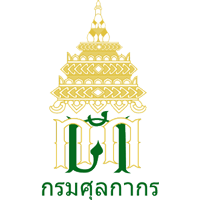Freight Shipping Between Thailand and Russia | Rates – Transit Times – Taxes
Are you about to import/export products from Thailand to/from Russia? Opportunities in Thailand, particularly in contract manufacturing, remain highly competitive, and the country remains one of Russia’s largest trading partners in volume. In addition, logistics from Thailand to Russia is a booming sector, with many providers offering comprehensive services to meet companies’ shipping needs. As it is very difficult for you to find clear and accurate information on the internet, you will find here, through our guide, all the useful and relevant information concerning the different shipping methods and regulations for importing your products into Russia.
Whether you are a large company, an SME, a start-up, or an individual, Siam Shipping can organise the transport of your goods between Thailand and Russia, without you having to do anything. Tell us about your project, so that our experts can find the most appropriate solution for your freight and advise you on how to save on shipping costs. We’ll answer all your questions!
Russia’s eco-political situation after the war in Ukraine
The recent conflicts between Russia and Ukraine have not escaped anyone’s notice, and to counter the economic activities of its opponents, Russia has taken a number of measures.
As far as import-export activities are concerned, the economic and political situation in Russia following the war in Ukraine has had a number of implications. Here are some important points to bear in mind:
Economic sanctions
Russia faced economic sanctions in response to its annexation of Crimea and its alleged support for separatists in eastern Ukraine. These sanctions were imposed by several Western countries, including the United States and the European Union. Trade relations between Russia and these countries have been restricted by these sanctions, particularly with regard to exports and imports of goods and services.
Reduced trade
Geopolitical tensions and sanctions have considerably reduced trade between Russia and Ukraine, as well as between Russia and other Western countries. This has had a negative impact on Russia’s import-export operations, particularly in areas where Russia is heavily dependent on foreign markets.
Diversification of trading partners
Russia has sought to diversify its trading partners and strengthen its economic relations with other countries, particularly those in Asia. Russia, for example, has consolidated its trade links with China, becoming an important trading partner in a number of areas. This has enabled Russia to partially offset the decline in trade with Europe and the United States.
Promoting regional trade
Russia has also sought to encourage regional trade in Eurasia. It has participated in initiatives to encourage trade and economic cooperation between member countries, such as the Eurasian Economic Union (EEU) and the Shanghai Cooperation Organisation (SCO). Russia has been able to develop its trade relations with other nations in the region thanks to these initiatives.
Effects on the Russian Economy
The Russian economy has slowed down, with a drop in foreign investment and a depreciation of the rouble. Nevertheless, Russia has tried to reduce its dependence on imports by developing certain economic sectors, such as agriculture and industry.
What is the most suitable method of transport between Thailand and Russia?
There are 3 modes of transport, the main transportation methods from Thailand to Russia include air freight, sea freight. However, in the situation of Thailand from Russia, rail freight is really not recommended because of the great distance between the two countries.
Therefore, for transportation from Russia to Thailand, the same methods apply to sea freight, air freight, and rail freight.
The type of goods being transported, the urgency of delivery, and economic considerations are only a few of the variables that influence the best mode of transportation between Thailand and Russia.
Sea Freight: When shipping substantial amounts of cargo between Thailand and Russia, sea freight is frequently chosen. It is affordable and appropriate for non-perishable commodities. Although the transit time is greater than other forms of transportation, it might still be a dependable option for items that are not time-sensitive.
Air Freight: The quickest kind of transportation, air freight is appropriate for commodities that must arrive quickly or are of great value. Although it provides for faster delivery between Thailand and Russia, air freight can be more expensive. For urgent shipments or perishable items, air freight is best.
Docshipper Note:
Besoin d'aide pour votre expédition ? N'hésitez pas à nous contacter, même pour une simple question. Choisissez l'option qui vous convient.
Chat en direct avec un expert Discutez-nous sur WhatsApp Remplissez le formulaire
Sea freight between Thailand and Russia
Overview – Ocean cargo between Thailand and Russia
Trade relations between Russia and Thailand
Having not sided with Russia during the war in Ukraine, Thailand, like many other countries, has obviously been penalised on exports.
Indeed, the value of Thai exports to Russia will continue to fluctuate wildly as a result of the Russia-Ukraine conflict.
RUSSIA-THAILAND
In 2021, Russia exported $593M to Thailand. The main products that Russia exported to Thailand are Planes, Helicopters, and/or Spacecraft ($100M), Raw Aluminium ($94.7M), and Mixed Mineral or Chemical Fertilizers ($70M). During the last 26 years, the exports of Russia to Thailand have decreased at an annualized rate of 2.38%, from $1.11B in 1995 to $593M in 2021.
THAILAND-RUSSIA
In 2021, Thailand exported $1.22B to Russia. The main products that Thailand exported to Russia were Cars ($148M), motor vehicles; parts and accessories (8701 to 8705) ($100M), and Rubber Tires ($69.4M). During the last 26 years, the exports of Thailand to Russia have increased at an annualized rate of 4.39%, from $400M in 1995 to $1.22B in 2021.
COMPARISON
In 2021, Russia ranked 45 in the Economic Complexity Index (ECI 0.46), and 10 in total exports ($484B). That same year, Thailand ranked 29 in the Economic Complexity Index (ECI 0.97), and 25 in total exports ($285B).
Main ports in Russia
 Port of St. Petersburg
Port of St. Petersburg
Seaport on the Baltic Sea, serving the city of St Petersburg in northwest Russia. It is the second-largest commercial port in Russia.
Additional information:
- The port covers an area of 164.6 km 2
- The berthing quays are 31 km long, and the maximum depth at the deepest anchorages is 25 metres.
Port of Ust-Luga
Seaport on the Baltic Sea, Ust-Luga was planned to become a port for coal and fertilisers with a capacity of 35 million tonnes a year, with the aim of avoiding having to route traffic through the ports of the Baltic countries.
Additional information:
- The maximum length of the vessels recorded to having entered this port is 293 meters.
- The maximum draught is 14 meters.
- The maximum Deadweight is 185897t.
Port of Primorsk
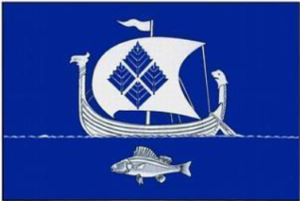
Primorsk Port is the largest Russian oil-loading port in the Baltic Sea and the end point of the Baltic Pipeline System. The port is located on the Björkösund mainland of the Gulf of Finland in the Baltic Sea, 5km south-east from the town of Primorsk.
 Laem Chabang Port
Laem Chabang Port
The Laem Chabang Port is located about 130 kilometers southeast of Bangkok in Chonburi province. It is the second-largest port in Thailand and is connected to the national
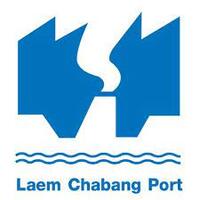 railway network for the transportation of goods to the interior of the country.
railway network for the transportation of goods to the interior of the country.
Map Ta Phut Port
Located in Rayong province, the Map Ta Phut Port is on the east coast of Thailand, this port is an important center for the country’s petrochemical industry. It has a rail yard and is connected to the national rail network.
Chiang Saen Port
The Chiang Saen Port is located on the Mekong River in Chiang Rai province, near the border with Laos. It is used for the transport of goods between Thailand and the neighboring countries, in particular Laos and China.
Transit time between Russian ports and Thailand ports
Here is a summary table of the average transit times, in days, between the largest Russian and Thai ports.
| Bangkok | Laem Chabang | Map Ta Phut | Chiang Saen | |
|---|---|---|---|---|
| Port of St. Petersburg | 54 | 38 | 38 | 40 |
| Port of Ust-Luga | 54 | 38 | 38 | 40 |
| Port of Primorsk | 54 | 38 | 38 | 40 |
*These transit times between Russia and Thailand are given as an indication.
Container complet ou FCL (Full Container Load)
This type of shipment, allows several people, who do not have enough goods to fill an entire container, to use the same container. The goods of various people are thus combined to fill an entire container.
This is the most cost-effective choice for small shipments of less than 15 m³.
Groupage maritime ou LCL (Less than Container Load)
For this type of shipment, one person will use the entire capacity of the container. This minimizes the risk of damage to the goods.
This method would still be advantageous even if you did not fill the container completely. However, it is the most cost-effective for shipments over 15 m³.
Advantages of LCL
- The advantageous rate for small volumes.
- Allows for fewer but more frequent shipments, reducing storage expenses.
Disadvantages of LCL
- Often longer delivery times due to loading and unloading of goods from all customers.
- Increased risk of loss and damage from multiple loading and unloading.
Advantages of FCL
- The advantageous rate for large shipments of goods.
- Reduced risk of damage or loss of goods because containers are not opened during transit.
Disadvantages of FCL
- A minimum volume of at least 15 m³ to be profitable.
Special transports by sea between Thailand and Russia
Reefer container
The reefer container is used to transport chemicals or perishable products at controlled temperatures. It is equipped with a cooling system.
Roro
RORO (Roll On/Roll Off) vessels are used to transport vehicles such as cars, trucks, vans, semi-trailers, and rail cars. They are considered the safest and most efficient vessels for heavy or special cargo.
Bulk
Bulk carriers are used to transport solid bulk materials such as minerals, grains, coal, or liquids such as crude oil, gas, and chemicals. These vessels are larger and easier to load and unload.
OOG
OOG cargo is cargo that exceeds the dimensions of a standard container. Two types of containers exist for these goods:
- Open Top Container: they have no roof, which allows loading cargo that exceeds the height of the containers.
- Flat Rack Container: these are flat containers without side walls or roofs, used for goods that cannot be loaded in standard containers.
How much does the sea freight cost between Thailand and Russia?
The cost of sea freight between Russia and Thailand will depend on several factors such as the type of cargo being shipped, the volume and weight of the cargo, the distance between the ports of origin and destination, the shipping method, and the current market conditions.
In general, the average cost of shipping a 20-foot container (TEU) from Russia to Thailand is approximately US$2.500 to US$5.500, depending on the shipping company, the port of origin and destination, and the time of year.
It is possible to estimate the cost if you know the exact weight and volume of your goods. To do this, you must follow these 3 steps:
- Determine the PU (Paying Unit): for this, you need to compare the mass and volume of your cargo based on the theory of sea freight, which states that one ton = 1 m³. The higher value between volume and mass will be the UP. For example, for a volume of 20 m³ and a mass of 25 tons, the UP will be 25 tons.
- Calculate the basic freight: to do this, multiply the cost of the UP by its number.
- Calculate the net freight: with the following formula, Base freight + BAF + CSP – Rebate. The result will be the cost of your sea freight.
Tariff surcharges
Tariff surcharges may apply on your transport between Russia and Thailand, here are the main ones:
- Bunker Adjustment Factor (BAF): This surcharge is applied according to fluctuations in the price of fuel and may vary regularly depending on market conditions.
- Security Surcharge (SCS): This surcharge is applied to cover costs related to port and vessel security.
- Overcapacity surcharge (OWS): This surcharge is applied when demand for shipping is lower than supply, resulting in excess vessel capacity.
- Congestion surcharge (CGS): This surcharge is applied in ports where congestion is high, resulting in extended waiting times for ships.

Air freight between Thailand et Russia
Classic or Express air freight
There are two types of air freight:
- Classic air freight: This option uses the space available on board commercial flights of airlines such as Air France, Thai Airways, China Southern Airlines, or even Qatar Airways, and exploits the empty spaces.
- Express airfreight: This option uses aircraft dedicated solely to airfreight. This solution is offered by courier companies, such as FedEx, DHL, UPS, or even TNT, which offers door-to-door solutions.
Main airports in Russia
Moscow Sheremetievo Airport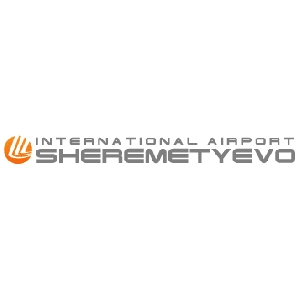
Moscow Sheremetyevo Airport is Russia’s busiest airport, with six terminals and three runways. It is about 29 kilometres northwest of Moscow city centre.
Additional information:
- 19 cargo destinations in 13 countries
- 379 000 tons of cargo and mail in 2019
- Russia’s largest cargo airport
Moscow Domodedovo Airport

Moscow Domodedovo Airport is Russia’s second-busiest airport after Moscow Sheremetyevo Airport. It is also Russia’s second-busiest airport for freight.
Additional information:
- 20 freight destinations and 4 airlines
- 140000 tons of cargo in 2019
- The warehouse area is 17 300 m23
St Petersburg Pulkovo

St Petersburg Pulkovo Airport is located to the south of the city and is Russia’s 3rd busiest airport. Pulkovo is one of the largest airports in Russia and Eastern Europe.
Additional information:
- 31st busiest airport in Europe
- 18 million passengers in 2022
- total area = 240 m2, and total volume = 1200 m3
Main airports in Thailand
Suvarnabhumi Airport
 Suvarnabhumi Airport is a major cargo hub for the Asia-Pacific region, offering direct air connections to many international destinations.
Suvarnabhumi Airport is a major cargo hub for the Asia-Pacific region, offering direct air connections to many international destinations.
Additional information:
- It has the highest control tower in the world.
- Its terminal is the third largest in the world with 56.3 hectares.
- Forecasted increase in cargo and aviation capacity.
Don Mueang Airport
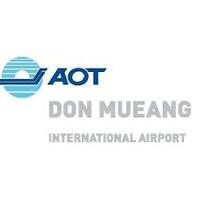 Don Mueang is considered one of the oldest international airports in the world. Commercial flights began in 1924, making it one of the oldest commercial airports in the world.
Don Mueang is considered one of the oldest international airports in the world. Commercial flights began in 1924, making it one of the oldest commercial airports in the world.
Additional information:
- 700,000 tons of cargo were handled by this airport.
- It worked with 80 airlines
Chiang Mai Airport
 Although Chiang Mai Airport is not as large as Bangkok Airport, it plays an important role in the logistics of the northern region of Thailand by providing direct connections to major domestic and international destinations.
Although Chiang Mai Airport is not as large as Bangkok Airport, it plays an important role in the logistics of the northern region of Thailand by providing direct connections to major domestic and international destinations.
Additional information:
- 16,000 tons of annual cargo
- More than 15,000 flights and 2,000,000 passengers annually
What are the advantages of air freight?
- Speed of transport
- Rarely late
- Good geographical coverage
What are the disadvantages of air freight?
- High price
- Not possible to transport really heavy goods
- The security at the airport is much higher which can make you lose time during the control
How much does it cost to transport cargo by air from Thailand to Russia?
To know the price of your goods transported from Thailand to Russia by air freight, you must consult the tariffs of the airline companies. Their tariffs are presented by weight bands in decreasing prices.
The weight taken into account by the airlines will always be the one that is to their advantage, that is to say, the highest between the real weight and the volumetric weight.
Siam Shipping Advice
It can be difficult to estimate the exact price of your airfreight shipment yourself. Contact us to receive a free quote within 24 hours.
How to calculate the volumetric weight of your shipment?
The volumetric weight is the volume occupied by a package, based on its dimensions and its gross weight. To know it, you must measure the dimensions of the package (length, width, and height), then convert them into cubic meters. Then use the formula below:
Volumetric weight = (length x width x height) / 5000
Siam Shipping Advice
We recommend using air freight for fragile, valuable, or perishable goods to increase security and protect your merchandise. You can get in touch with our specialists for further details if you want to learn more about transporting fragile merchandise.

Door-to-door delivery between Thailand and Russia
If you don’t have time to devote to transportation, door-to-door delivery is for you. This method is simple, your goods will be picked up directly at your home, and then delivered to the desired destination. You will not need to take care of anything and your goods will be safe with professionals.
What are the advantages of door-to-door services?
- Quick delivery: As everything is completed in a 24-hour period, you can send it if your delivery time is during the day.
- Door-to-door delivery is always available, so your package will come even late at night or on a holiday.
- Convenience: Receiving the package at your location rather than having it delivered to you is better for you.
- Your cargo can be qualified for courier delivery if it is a manageable size.
What are the disadvantages of door-to-door services?
- High cost: The cost increases with the urgency of the cargo, as well as with the package’s size and weight, which also affect the cost.

Customs clearance in Russia for goods imported from Thailand
Customs clearance in any country is an important and mandatory step that must be done when importing and exporting.
When you import goods in Russia, the customs clearance will consist in paying the customs duties and the VAT. It is also necessary to be attentive to the regulations and standards of the country where you are shipping to avoid having your goods blocked at customs.
Here are the prohibited and regulated products in Russia:
- Prohibited products: narcotics, weapons, explosives, counterfeit currency, hazardous materials, and certain animal and plant species protected under international agreements…
- Regulated products: industrial chemicals, solvents, water treatment chemicals, medicines, skin care products, hair care products, perfumes, make-up products, cell phones, computers, telecommunications equipment, meat products, dairy products, seafood products, pesticides, etc.
What are the customs duties and taxes in Russia?
- Import Customs Duties: Customs duties are calculated as a percentage of the customs value of the imported goods. The rates can vary widely depending on the product classification under the Harmonized System (HS) codes. The customs duty rates typically range from 0% to several dozen percent.
- Value-Added Tax (VAT): VAT is applied to the customs value of the goods, including the customs duties. The standard VAT rate in Russia is 20%. However, certain goods may qualify for reduced VAT rates or exemptions based on specific criteria or trade agreements.
- Excise Taxes: Excise taxes may apply to specific goods such as alcohol, tobacco, petroleum products, and certain luxury items. The rates and calculation methods for excise taxes vary depending on the product category.
- Anti-Dumping Duties: In cases where imported goods are found to be sold at significantly lower prices than the domestic market, anti-dumping duties may be imposed to protect domestic industries. These duties are imposed on top of the regular customs duties.
- Environmental Fees: Certain goods that have a potential impact on the environment may be subject to environmental fees. These fees are imposed to support environmental conservation efforts and are calculated based on the quantity or weight of the goods.
- Additional Taxes and Charges: There may be additional taxes, fees, or charges applicable to specific goods, such as special customs duties, transport charges, or specific industry-related fees.
How to calculate customs duties and taxes
Calculating customs duties and taxes on imports into Russia can be a complex process that depends on several factors, such as the type of product, its value, and its country of origin. Here are the general steps to follow:
- Determine the product’s tariff classification: The first step in calculating customs duties is to determine the product’s tariff classification. You’ll need to know the Harmonized System code for your product to determine its tariff classification.
- Determine the Customs Value: The customs value is the value of the imported goods for customs purposes. It generally includes the cost of the goods, freight charges, insurance, and any other expenses related to the transportation of the goods to the Russian border.
- Calculate the customs duty: Once you have determined the product’s tariff classification and value, you can calculate the customs duty. The duty rate will depend on the product’s tariff classification, its value, and the country of origin.
- Calculate Value-Added Tax (VAT): VAT is applied to the customs value plus the customs duty. The standard VAT rate in Russia is 20%. To calculate VAT, multiply the combined customs value and duty amount by the VAT rate. For example, if the combined customs value and duty amount is $11,000, the VAT would be $2,200 (20% of $11,000)
- Calculate any other taxes or fees: Depending on the product, there may be other taxes or fees to consider, such as excise duties or environmental taxes.
It’s important to note that the customs clearance process and the calculation of duties and taxes can be complex. If you’re unsure about how to calculate the duties and taxes for your specific import, it’s always best to consult with a customs broker or freight forwarder like Siam Shipping. We can help you navigate the process and ensure that you’re meeting all the necessary requirements.
How to find the HS code?
A system of classification for products used in international trade is the HS code. It organizes goods into categories based on their nature and intended use, making the collection of statistical data and the customs clearance process easier. The HS system contains more than 5,000 different products, each of which is categorized using a distinct eight-digit number.
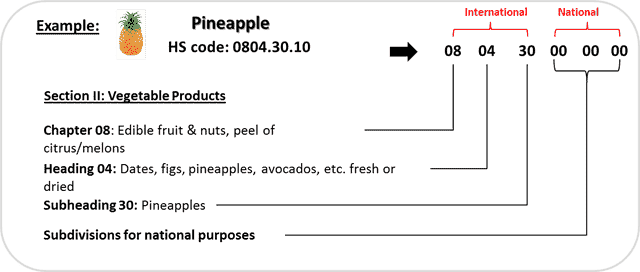
You can consult these websites to know the HS code of the Thailand products and the Russian products.
Calculating customs duties with the HS Code
Here is a small illustrated guide to help you understand how to do it:
Enter the product you’re going to import to Russia from Thailand in this website.
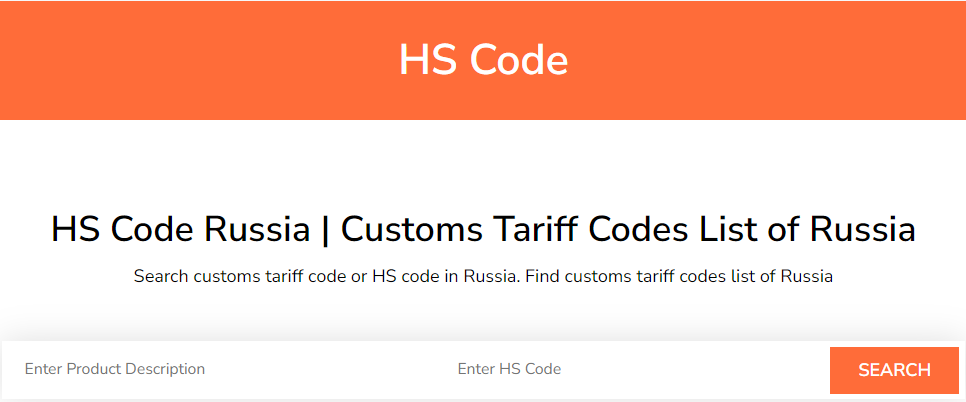
Then, consult taxes applicable to your product.
Does Siam Shipping charge customs duties?
No, no commission is taken from Siam Shipping. As proof, we will send you all the official documents provided by Russian customs. We will only collect the customs clearance fees, as we declare your goods to the customs for you.
The fees associated with customs duties and taxes will be collected by the Russian government.
Customs procedures and contact
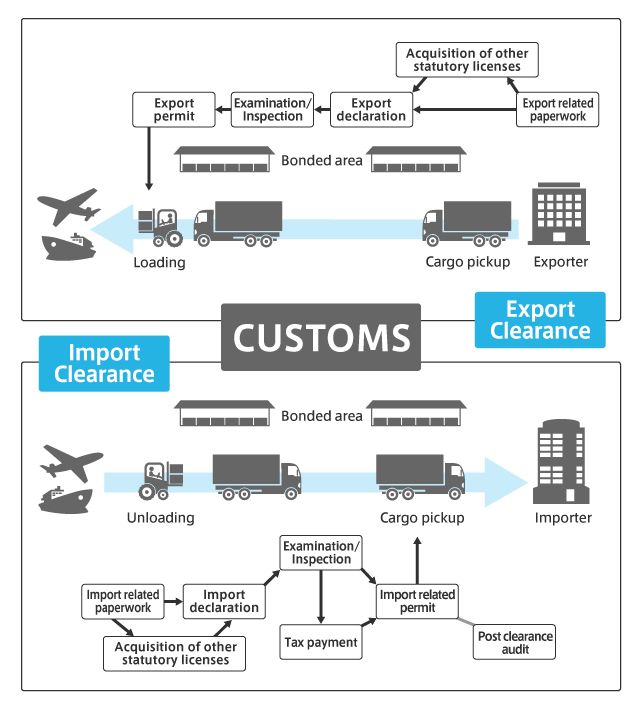
The customs services
Russian Customs
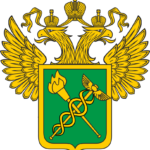
Official name: Federal Customs Service of Russia
Федеральная таможенная служба
Official website: Russian Customs
Required documents
Original invoice
It is an essential document to allow the clearance of goods in Russia and Thailand.
Bill of lading
This document is used to prove that the product has been delivered by the exporter and records all the details of the transport procedure.
The packing list
This is a complete list created to detail the items that the shipper is shipping. It is essential throughout the shipment and must be present at every stage of the product delivery.
Certificate of Origin
This document certifies the country of origin of the goods.
CE conformity
A certificate of conformity is a document that proves that a product complies with environmental, safety, and health requirements.
Additional logistics services
Venture beyond shipping and customs with SIAM Shipping! Explore our wide array of additional logistics services, ensuring your supply chain operation runs smoothly from start to finish. Let's take care of everything, together.
Warehousing and storage
Finding the right warehouse for your goods can feel like a treasure hunt—a steady temperature for your delicate items is a must. Storing chocolates? You wouldn’t want a meltdown! For a stress-free solution that considers all conditions, explore our warehousing services, designed to keep your goods in prime condition.
Packaging and repackaging
Inherent challenges in shipping from China to France make quality packaging vital. Having a reliable agent can help ensure your wine barrels or electronics are suitably packed and repacked, reducing the risk of damages. Whether it's ceramics securely cushioned or machinery components assembly-segregated, great packaging caters to every product. Find out more about securing your cargo on our dedicated page: Freight packaging.

Cargo insurance
Contrary to fire insurance limited to premises, transport insurance is your flotation device over rough trade seas. Imagine sending a pricey, custom-built machinery and it gets damaged in transit. Ouch! But, with cargo insurance, you're covered and can breeze through such setbacks. It's the booster dose of prevention to keep your trade immunity sky-high.
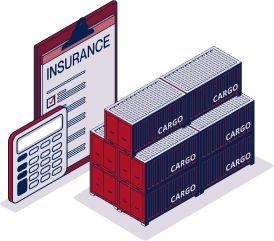
Personal effects shipping
Moving precious belongings from China to France? No worries, we manage fragile or bulky items with extra care, ensuring they reach your new French home intact. Like Aunt Mei's porcelain vase, we pack, transport, and deliver with professionalism. Save time and energy for croissants and vin rouge!

FAQ | Freight between Thailand and Russia
The best way to transport freight between Thailand and Russia depends on various factors such as the nature of the goods, the quantity, the urgency of the delivery and the sender's preferences. Common options include air, sea and overland transport.
Air freight: This is generally the fastest way to ship goods between the two countries, but it can be more expensive than other modes of transport.
Sea freight: This is often used for larger or less urgent freight shipments. It may take longer than air transport, but costs can be more economical.
Road freight: If Thailand and Russia share a land border, road freight can be a viable option, particularly for smaller freight shipments. However, it should be noted that distance and customs formalities can influence the length and complexity of overland transport.
The fastest way to ship goods to Russia is generally by air. Cargo flights offer shorter delivery times than sea or land transport. However, it is essential to take into account the higher costs associated with air transport.
Russia has specific restrictions on the import of certain products and goods. Restrictions may relate to categorise such as food products, pharmaceuticals, weapons, hazardous substances, radioactive materials, counterfeit goods, etc. It is important to consult Russian customs regulations and work with a freight forwarder or customs agent to ensure compliance with shipping restrictions in Russia.
The products most commonly imported from Thailand to Russia can vary according to time and trade trends. However, some products commonly imported from Thailand to Russia include electronics, textiles and clothing, automotive parts, food products (such as tropical fruits, rice, seafood), rubber products and chemicals.
The products that Thailand imports most from Russia can also vary. Some examples of products imported from Russia by Thailand include petroleum products, chemical products, metal products, machinery and equipment, agricultural products, etc.






